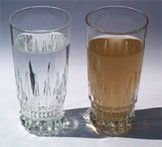Dissolved Sulfate
SOURCES
Sulfates (SO4) are salts of sulfuric acid (H2SO4). They occur naturally in rain water, or man-made from industrial waste, battery acid, Epsom salts, plaster, some drugs, and algaecides. Many of the sulfate salts are highly soluble in water. Sulfates occur as microscopic particles from fossil fuel burning and can create acid rain. There are two types of bacteria associated with sulfate: sulfate reducing and sulfate oxidizing. Sulfate reducing bacteria live where there is little or no oxygen (such as deep wells, plumbing systems, water softeners, and water heaters), and they convert sulfate and other sulfur compounds to hydrogen sulfide gas (gives off a rotten egg smell). They are usually found in the hot water plumbing. Sulfur oxidizing bacteria convert sulfide to sulfate, making a dark slime that clogs piping, stains clothes, and blackens water (these are less common than the reducing bacteria).
CONCERNS
The Environmental Protection Agency set a secondary drinking water regulation maximum limit for sulfate at 250 mg/L (parts per million). This is because dissolved sulfate has a bitter or medicinal taste, it corrodes copper piping, it can cause extreme hardness, a scale can build up on piping, and it can have a laxative effect (30 grains per gallon or more are consumed when combined with calcium and magnesium).
REMEDIES
Treatment depends upon the form and quantities of sulfate, the amount of iron, manganese, and bacteria, and how much water must be treated. For a small amount of water, distillation and reverse osmosis; and ion exchange for large quantities. The last option is to find an alternative water source such as bottled water, or tapping into the city water system.
For more information check out the following links

